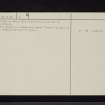Pricing Change
New pricing for orders of material from this site will come into place shortly. Charges for supply of digital images, digitisation on demand, prints and licensing will be altered.
Dumfries, Castledykes
Castle (Medieval), Motte (Medieval)
Site Name Dumfries, Castledykes
Classification Castle (Medieval), Motte (Medieval)
Alternative Name(s) Castledykes Park, Motte And Bailey, Medieval Castle And Associated Earthworks
Canmore ID 65688
Site Number NX97SE 2
NGR NX 9775 7467
Datum OSGB36 - NGR
Permalink http://canmore.org.uk/site/65688
- Council Dumfries And Galloway
- Parish Dumfries
- Former Region Dumfries And Galloway
- Former District Nithsdale
- Former County Dumfries-shire
NX97SE 2.00 9775 7467
NX97SE 2.01 NX 9775 7467 Chapel
NX97SE 2.02 Cancelled: see NX97SE 94
(NX 9775 7467) Castle(NR) (site of)
OS 6" map (1970)
A royal castle was established on the motte at Castledykes. It was rebuilt in stone in the 1260's and during the Edwardian occupation, a great ditch was dug around the castle, which was also encircled by a wooden paling. There is a strong belief that this castle was destroyed after its capture by Bruce in 1313 and was not rebuilt.
SBS Dumfries 1977
The RCAHMS state that it is not now possible to determine the layout of the castle due to landscaping, but describe the oblong mound SE of Castledykes mansion as the remains of a motte, where remains of a ditch and rampart may be seen round its E and S sides; the associated bailey probably extended W towards the river. Small scale excavations here in 1953 revealed traces of walling, just SW of, and also N of the flagstaff (see NX97SE 2.1.) Some 20 pieces of pottery, mainly 13th / 14th century in date, were recovered and are now in Dumfries Museum.
(This castle is erroneously named "Comyn's Castle" on earlier editions of the OS maps.)
RCAHMS 1920, visited 1915; A E Truckell 1955; A E Truckell and J Williams 1967; J Williams 1968.
Online Gallery (1306 - 1329)
The year 2014 sees the 700th anniversary of the Battle of Bannockburn, in which the army of Robert I of Scotland defeated that of Edward II of England. The battle marked a major turning point in the long, drawn-out struggle of the Wars of Independence.
The Wars have had a lasting influence upon all the nations of the United Kingdom and upon the national story. Each age has seen fit to commemorate the events in its own way: through the perpetuation of the genuine historical associations of buildings and places and also through the endowment of others with improbable or fanciful traditions. Where past generations allowed its historic buildings to decay and disappear, later generations began to value and actively preserve these for their associations. Where an event lacked a tangible reminder, as at Kinghorn where Alexander III was killed in a riding accident, a commemorative monument would be erected to act as a focus. The Wars of Independence predate the fashion for accurate portraiture: the weathered, generic military effigy of Sir James Douglas is one of the few to survive in Scotland. Later centuries saw a need and supplied it by a crowd of images of its historic heroes, William Wallace and Robert the Bruce, each depicted according to contemporary taste and imagination. The opening of the new heritage centre at Bannockburn takes this into a new dimension, through the use of three-dimensional, digital technology.
RCAHMS Collections hold many images of these buildings and locations from battlefields, castles and churches, to the many commemorative monuments erected in later years. This gallery highlights a selection of these, including antiquarian sketches, photographic and drawn surveys, and architectural designs.
Publication Account (1977)
The royal castle was established on the massive motte of Castledykes, located nearly a mile to the south of the centre of Dumfries. A castellated structure at Castledykes reputedly dates to at least the late twelfth century (Truckell (1), n. d., 7), and there is mention of a chapel of St. Mary at Castledykes in the early thirteenth century (Barbour, 1905-6, 49). The castle was rebuilt in stone in the 1260s and workmen during the Edwardian occupation dug a great ditch around the castle as well as constructing a wooden paling to encircle it. In 1335 Sir Eustace Maxwell of Caerlaverock, who held Dumfries for Edward III, noted in a revenue return that 'of the mote of the castle and certain royal lands called Kingsholm at Dumfries which are wont to be worth 60 shillings there is no reply' (Barbour, 1905-6, 49). The castle and Kingsholm were thus united as they are today. The belief is strong that Dumfries Castle was destroyed after its capture by Bruce in 1313 and was not rebuilt.
Information from ‘Historic Dumfries: The Archaeological Implications of Development’ (1977).
Watching Brief (9 February 2010 - 10 February 2010)
Watching brief during excavation of new cycleway within scheduled area, just outwith the main defensive ditch to the NE of the castle.
Dumfries and Galloway Council (A. J. Nicholson) OASIS ID: dumfries2-73000
Geophysical Survey (7 September 2012)
NX 9775 7467 A small scale community geophysical survey was carried out on 7 September 2012 by volunteers as part of a series of events by Discovering Dumfries and Galloway’s Past, run by the University of Glasgow. The resistance survey recorded a number of anomalies across and to the immediate N of Castle Hill, the site of the former Royal Castle of Dumfries. At least some of these anomalies may relate to stone built features, although the limited nature of the survey made interpretation tentative.
Report: Dumfries and Galloway SMR
Funder: The Scottish Government and The European Community, Dumfries and Galloway LEADER 2007–2013, The Crichton Foundation and The University of Glasgow
Giles Carey, University of Glasgow
2012
Field Visit
For a possible barbican associated with the castle, see NX97SE 19, Dumfries, 'Paradise'.
T C Welsh, MS 4032 and T C Welsh, 2007f.










